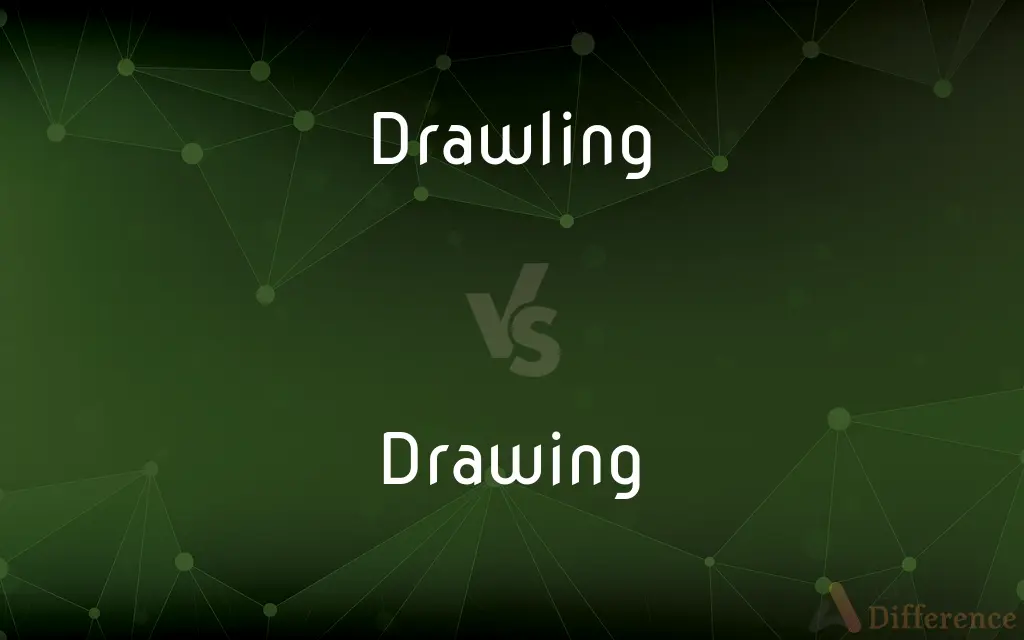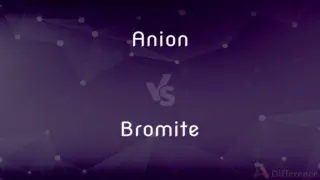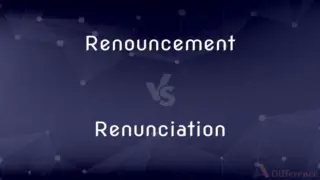Drawling vs. Drawing — What's the Difference?
By Urooj Arif & Maham Liaqat — Updated on April 3, 2024
Drawling is the act of speaking slowly with prolonged vowels, while drawing involves creating art with lines or marks on a surface.

Difference Between Drawling and Drawing
Table of Contents
ADVERTISEMENT
Key Differences
Drawling refers to a specific manner of speaking, characterized by elongating vowels and speaking in a slow, sometimes melodious manner. This can be associated with certain accents or deliberate speech styles, often perceived as laid-back or nonchalant. In contrast, drawing is the act of producing images, shapes, or designs on a surface using tools such as pencils, pens, brushes, or digital instruments. It's a fundamental form of visual art that captures ideas, expressions, or objects through line work.
While drawling affects auditory perception and is linked to speech patterns and accents, drawing impacts visual perception, engaging viewers with artistic expressions. Drawling can convey a speaker's cultural background or emotional state, such as relaxation or indifference. Meanwhile, drawing serves multiple purposes, from artistic and educational to therapeutic, offering a means to visualize concepts, tell stories, and explore creativity.
The skills involved in drawling and drawing are distinct; drawling requires control over one’s vocal cords and the ability to modulate speech patterns, often without formal training. Drawing, however, typically requires practice and skill development in understanding shapes, perspectives, and shading to create visually coherent works.
Drawling has no tangible product, existing only as long as the speech act continues. Drawing results in a physical or digital artifact that can be viewed, shared, and preserved. It reflects the artist's skill, perspective, and intent, making it a medium of lasting expression and communication.
Both drawling and drawing are forms of expression, with the former being auditory and the latter visual. They highlight the diverse ways humans communicate and express creativity, through speech and visual art, respectively.
ADVERTISEMENT
Comparison Chart
Definition
Speaking in a slow, prolonged manner.
Creating images or designs on a surface.
Medium
Auditory - speech patterns.
Visual - lines and marks on a surface.
Purpose
To convey speech in a distinct, often regional or relaxed tone.
To visualize ideas, tell stories, or express creativity.
Skills
Control over vocal modulation and tone.
Artistic skills like understanding of shapes, perspective, and shading.
Outcome
Ephemeral, exists in the moment of speech.
Tangible artwork that can be preserved and shared.
Compare with Definitions
Drawling
Speaking slowly with prolonged vowels.
His drawling voice added a relaxed vibe to the story.
Drawing
Can be digital or traditional in medium.
Digital drawing has opened up new possibilities for artists.
Drawling
A speech pattern often associated with certain regions.
The Southern drawl is recognizable across the United States.
Drawing
A fundamental skill in visual arts.
Drawing classes help develop a strong foundation in art.
Drawling
Deliberate modulation of speech for effect.
She adopted a drawling tone to mimic the character accurately.
Drawing
The act of making marks on a surface to create an image.
Drawing has been her passion since childhood.
Drawling
Can indicate nonchalance or affectation.
The actor’s drawling speech pattern became his signature.
Drawing
Using tools like pencils, pens, or brushes for art.
He prefers drawing with charcoal for its texture.
Drawling
Characterized by a leisurely pace of speech.
His drawling greeting made him seem particularly laid-back.
Drawing
Serves as a form of expression and communication.
Through drawing, she communicates complex emotions.
Drawling
To speak with lengthened or drawn-out vowels.
Drawing
Drawing is a form of visual art in which an artist uses instruments to mark paper or other two-dimensional surface. Drawing instruments include graphite pencils, pen and ink, various kinds of paints, inked brushes, colored pencils, crayons, charcoal, chalk, pastels, erasers, markers, styluses, and metals (such as silverpoint).
Drawling
To utter with lengthened or drawn-out vowels
"We-e-ell," the clerk drawled.
Drawing
The act or an instance of drawing.
Drawling
The speech or manner of speaking of one who drawls
A Southern drawl.
Drawing
The art of representing objects or forms on a surface chiefly by means of lines.
Drawling
The act of speaking with a drawl.
Drawing
A work produced by this art.
Drawling
Present participle of drawl
Drawing
Present participle of draw
Drawling
The act of speaking with a drawl; a drawl.
Drawing
A picture, likeness, diagram or representation, usually drawn on paper.
Drawing
The act of producing such a picture.
Drawing
Such acts practiced as a graphic art form.
Drawing
The process of drawing or pulling something.
Proverb: An official is great in his office as a well is rich in drawings of water.
Drawing
An act or event in which the outcome (e.g., designating a winner) is selected by chance in the form of a blind draw, notably of lots; especially such a contest in which a winning name or number is selected randomly by removing (or drawing) it from a container, popularly a hat.
Drawing
A small portion of tea for steeping.
Drawing
The act of pulling, or attracting.
Drawing
The act or the art of representing any object by means of lines and shades; especially, such a representation when in one color, or in tints used not to represent the colors of natural objects, but for effect only, and produced with hard material such as pencil, chalk, etc.; delineation; also, the figure or representation drawn.
Drawing
The process of stretching or spreading metals as by hammering, or, as in forming wire from rods or tubes and cups from sheet metal, by pulling them through dies.
Drawing
The process of pulling out and elongating the sliver from the carding machine, by revolving rollers, to prepare it for spinning.
Drawing
The distribution of prizes and blanks in a lottery.
Drawing
An illustration that is drawn by hand and published in a book or magazine;
It is shown by the drawing in Fig. 7
Drawing
A representation of forms or objects on a surface by means of lines;
Drawings of abstract forms
He did complicated pen-and-ink drawings like medieval miniatures
Drawing
The creation of artistic drawings;
He learned drawing from his father
Drawing
Players buy (or are given) chances and prizes are distributed according to the drawing of lots
Drawing
Act of getting or draining something such as electricity or a liquid from a source;
The drawing of water from the well
Drawing
The act of moving a load by drawing or pulling
Common Curiosities
What does drawing involve?
Drawing involves creating images or designs on a surface using various tools, capturing ideas or expressions through line work.
How do drawling and drawing differ in terms of skills?
Drawling requires vocal control and modulation, while drawing demands artistic skills like understanding shapes and perspectives.
What is drawling?
Drawling is the act of speaking in a slow, elongated manner, often associated with specific accents or speech styles.
What are the purposes of drawing?
Drawing serves artistic, educational, therapeutic, and communicative purposes, allowing for visual expression and idea visualization.
Is drawing considered a form of art?
Yes, drawing is a fundamental form of visual art that expresses ideas, stories, and emotions through visual means.
What makes a drawing effective?
An effective drawing communicates the artist's intent, demonstrates skillful use of medium, and evokes an emotional or intellectual response.
How is drawling viewed in different cultures?
Drawling may be seen as charming or distinctive in some cultures, while others might view it as an affectation or laziness in speech.
How does drawling affect communication?
Drawling can affect the listener's perception of the speaker, conveying cultural background, emotional state, or a relaxed demeanor.
Is digital drawing considered authentic art?
Yes, digital drawing is a legitimate art form that utilizes technology to create artwork, offering new techniques and possibilities.
What materials are used for drawing?
Materials for drawing can include pencils, pens, ink, charcoal, crayons, and digital tools, among others.
Can drawling be learned?
While often associated with natural speech patterns, drawling can be adopted or modified through practice and mimicry.
Does drawling have any regional significance?
Yes, drawling can indicate a speaker’s regional background, such as a Southern drawl in the United States, adding to cultural identity.
Can everyone learn to draw?
While innate talent varies, most people can improve their drawing skills with practice and study, learning the fundamentals of art.
How can drawing be beneficial?
Drawing can enhance creativity, improve fine motor skills, serve as a therapeutic activity, and facilitate communication of ideas and emotions.
Are there professional careers in drawing?
Yes, professional careers in drawing include artists, illustrators, graphic designers, animators, and educators, among others.
Share Your Discovery

Previous Comparison
Anion vs. Bromite
Next Comparison
Renouncement vs. RenunciationAuthor Spotlight
Written by
Urooj ArifUrooj is a skilled content writer at Ask Difference, known for her exceptional ability to simplify complex topics into engaging and informative content. With a passion for research and a flair for clear, concise writing, she consistently delivers articles that resonate with our diverse audience.
Co-written by
Maham Liaqat














































